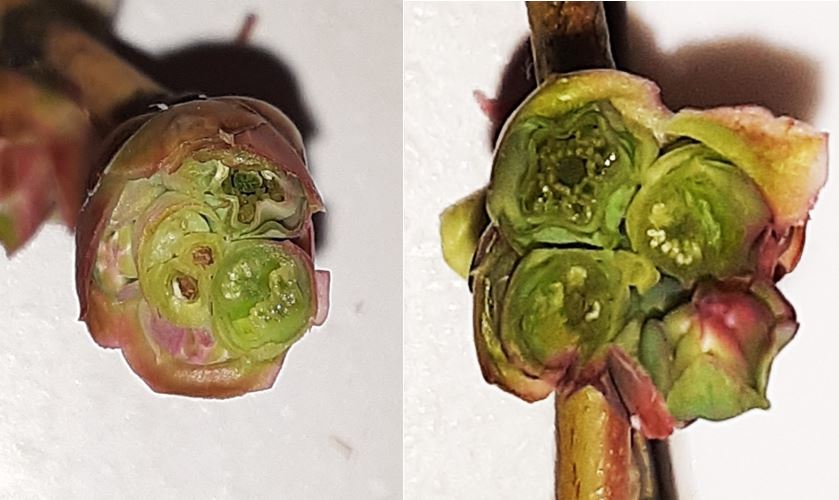West central Michigan small fruit update – May 7, 2019
Low temperatures delayed plant growth and development in small fruit crops. Some localized frost damage is observed in west central Michigan.

Weather report
Weather conditions in west central Michigan remain cold with sporadic rains that are keeping small fruit crops at early stages of development. Although no significant spring frost events have been registered, there are some symptoms of frost injury in early blueberry varieties and delayed growth in strawberries and raspberries.
Environmental conditions over the past seven days were characterized by a daily average minimum temperature of 41 degrees Fahrenheit and a daily maximum temperature of 58 F. Regarding precipitation, there were moderated rains that left an average of 1.37 inches of rain in the area. Up until May 7, accumulated precipitation in the area since Jan. 1 amounts to 9.6 inches. Those conditions of rain and temperature allowed an accumulation of no more than 2.7 growing degrees days (GDD) base 50 per day. So far, the amount of GDD accumulated since March 1 is approximately 109 GDD base 50.
Crop report
In raspberries, primocanes are coming out of the ground and foliage is developing on floricanes. However, due to prevailing low temperatures, their development is slow.
Strawberry leaves are developing from the crown, and in day-neutral varieties, some flowers are just starting to show up. There seems to be some problems related to the presence of black root rot, but most fields are developing fine. Growth has been delayed by current weather conditions.
Blueberries on the other hand are developing rapidly thanks to several days of good weather—sunny and temperatures above 60 F.
Although no important spring frost events have been reported in the area, winter temperatures and localized temperatures below 32 F that occurred during April caused some frost injury in early season varieties. Blueberry fields inspected for winter injury in Ionia, Conklin, West Olive, Pullman and Covert indicated that some degree of affectation occurred in early varieties, especially in Bluecrop and Bluetta.

We examined, with a dissection microscope, the first three terminal buds of 10 shoots randomly selected across the field. We found on average 30% flower buds completely damaged or partially damaged. In flower clusters in tight cluster or late pink stages, flower stamens were showing symptoms of frost damage and they looked blackened (see pictures). This damage will result in the loss of king flowers and will produce yield losses in affected fields. Affected flowers look good from the outside, but when they are dissected, they show freezing symptoms
Current GDD accumulation (base 50) since March 1 in west central Michigan is 109 GDD. It is time to start preparing for monitoring the beginning of cherry fruitworm adult emergence from their overwintering sites. Pheromone traps should be deployed this week, especially in fields with a history of fruitworm damage. Below are our predictive models for cherry fruitworm and cranberry fruitworm.
We are around 130 GDD from the predicted emergence of overwintering cherry fruitworm adults. The weather forecast for the next seven days indicates an accumulation of 145 GDD by the end of this week. However, for the Grand Junction, Michigan area, predicted GDD accumulation for the same period is 202 GDD. Visit Michigan State University Enviroweather to get updated information on current and forecasted GDD accumulations. Also, check the cherry and cranberry fruitworm models for oviposition starting period predictions
|
Insect |
First adults |
First eggs |
Current GDD accumulations as of May 7, 2019 | ||
|---|---|---|---|---|---|
|
Grand Junction |
Fennville |
West Olive | |||
|
Cherry fruitworm |
238 ± 30 |
432 ± 15 |
170 |
113 |
109 |
|
Cranberry fruitworm |
375 ± 20 |
460 ± 20 |
170 |
113 |
109 |



 Print
Print Email
Email



